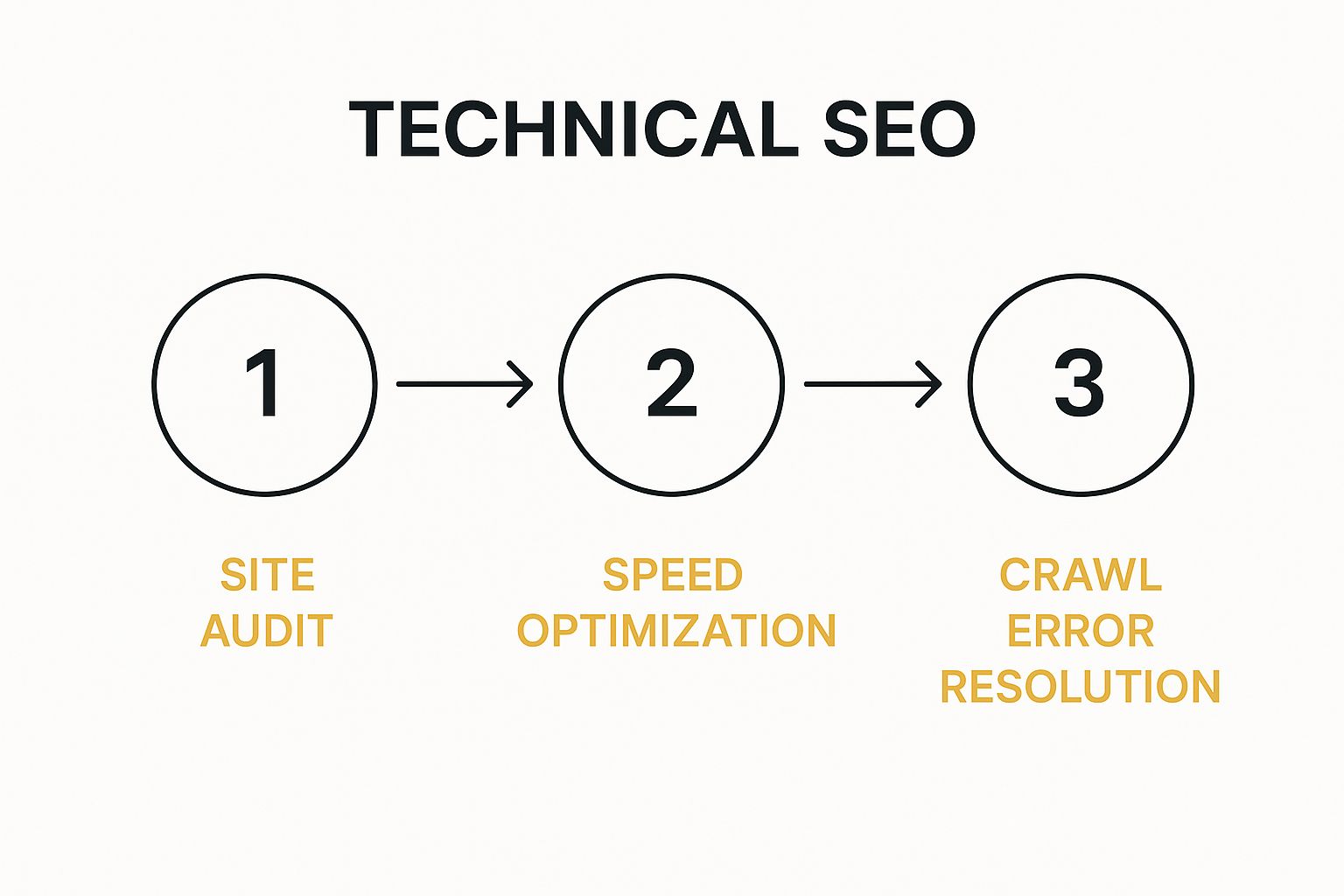When you boil it down, improving your website's SEO is all about a simple, powerful formula: create high-quality content that people actually want to read, make sure your site is technically solid for search engines to crawl, and build up your authority with reputable backlinks.
Getting a handle on these three pillars—on-page, technical, and off-page SEO—is the most reliable way to climb the rankings and pull in consistent organic traffic.
Your Blueprint for Dominating Search Rankings
Ready to see a real change in your website's performance? This is where you start. We're going to cut through the noise and give you a clear, actionable game plan for what it takes to improve SEO right now.
The core of any solid strategy comes down to three interconnected pillars. They all work together, and if you let one slide, the others can't pick up the slack. Balancing your efforts across these areas is the key to sustainable growth and a serious boost in visibility.
The Three Pillars of Modern SEO
To really move the needle with your SEO, you have to understand how each piece fits into the bigger picture. Neglecting one area completely undermines all your hard work in the others. For example, you could have the most amazing content in the world, but it won't rank if search engines can't technically crawl your site.
Let's break down the core components.
A successful SEO strategy really comes down to three distinct but related disciplines. Think of them as the foundation, the structure, and the curb appeal of your digital presence.
| SEO Pillar | Primary Focus | Key Activities |
|---|---|---|
| On-Page SEO | Content quality and relevance. | Keyword research, content creation, title tag optimization, internal linking. |
| Off-Page SEO | Building authority and trust. | Link building, guest posting, brand mentions, online PR. |
| Technical SEO | Site health and crawlability. | Site speed optimization, mobile-friendliness, XML sitemaps, structured data. |
Each pillar supports the others, creating a stable and effective strategy that can withstand algorithm updates and outperform the competition over the long haul.
The numbers don't lie. The global SEO services market hit about $90.3 billion in 2024 and is expected to jump to $106.9 billion in 2025. That’s an 18% increase in just one year, which shows just how critical these strategies are for businesses trying to get in front of organic search traffic.
A successful SEO strategy is like a three-legged stool. On-page, off-page, and technical SEO must all be strong and balanced. If one leg is weak, the entire structure becomes unstable and ineffective.
A great first step is to run a full diagnostic on your site. Using a comprehensive WordPress website audit checklist can help you pinpoint immediate areas for improvement. This will give you a solid framework to build on as we dive into the more detailed strategies.
Mastering On-Page SEO for Real Users

On-page SEO used to be a pretty straightforward game of keyword stuffing. Drop your target phrase in the title, sprinkle it in the text, and you were good to go. That approach is dead.
Today, if you want to improve your rankings, you have to get obsessed with the person behind the search. It's about satisfying user intent, not just matching keywords. That means digging deep to figure out not just what people are searching for, but why.
Uncovering What Your Audience Really Wants
Great on-page SEO kicks off long before you type a single word. It starts with keyword research that looks past raw search volume and zeroes in on what your audience actually needs. Sure, those high-volume keywords look tempting, but they're often too broad to turn a visitor into a customer.
Your goldmine is in long-tail keywords—those longer, more specific phrases people use when they're closer to making a decision. Someone searching for "best coffee shops omaha downtown" has a much clearer goal than someone just typing "coffee."
Here are a few practical ways to find these gems:
- Google's "People Also Ask" section is a direct line into your audience's brain. Check it for your core topics to see the exact questions they're asking.
- Dive into industry forums like Reddit or Quora. You'll find unfiltered conversations and pain points you can solve with your content.
- Check your own site's search data. What are people already looking for once they land on your website? It’s a huge clue.
This research gives you a clear roadmap. You'll be creating content that solves real problems, not just guessing what people want to read.
Structuring Content for Users and Search Engines
Once you know the questions your audience is asking, you need to structure your content so both people and search engine crawlers can make sense of it. This is where semantic SEO and smart internal linking come in.
Think of it as creating a web of interconnected content that proves your expertise on a topic. When you write a blog post on "The Benefits of a Custom Web App," it should naturally link over to your service page about web app development.
This simple act does two things at once: it gives your reader a better experience by guiding them to more relevant info, and it helps search engines understand how your pages are related. This builds your site's topical authority. If you really want to get this right, you'll need to go beyond basic keyword placement. Check out these advanced SEO copywriting tips to boost both user engagement and rankings.
Key Takeaway: Think of your website like a library. Your internal links are the signs that direct visitors to the right sections, making it easy for them to find exactly what they need without getting lost.
Crafting Titles That Earn the Click
Your title tag is your first impression in the search results. A great title can skyrocket your click-through rate (CTR), even if you're not in the #1 spot.
A winning title needs to be:
- Clear and Concise: Accurately describe the page's content in under 60 characters.
- Keyword-Focused: Include your main keyword naturally, ideally near the beginning.
- Benefit-Driven: Tell the user what's in it for them. "How to Improve SEO in 5 Actionable Steps" is way more compelling than just "SEO Guide."
And don't forget the meta description. While it's not a direct ranking factor, it's your supporting actor. Use it to back up your title's promise and add a clear call to action.
One of the biggest shifts for 2025 is how search engines use AI to interpret the intent behind a search. This means your content has to deliver the goods—whether the user wants information, needs to find a specific page, or is ready to buy. Getting this right has become more important than old-school keyword optimization.
Ultimately, mastering on-page SEO is about creating a valuable and seamless experience. When you give people clear answers, intuitive navigation, and compelling content, both users and search engines will reward you for it. For businesses ready to put these strategies into motion, professional https://upnorthmedia.co/services/seo-marketing can provide the expertise needed to really accelerate growth.
Building Authority with Strategic Link Building
 Once your on-page and technical SEO are buttoned up, it's time to show the rest of the internet that your site is worth visiting. That’s really what off-page SEO is all about: building your website's reputation and authority. And the main way you do that is through backlinks—links from other websites pointing to yours.
Once your on-page and technical SEO are buttoned up, it's time to show the rest of the internet that your site is worth visiting. That’s really what off-page SEO is all about: building your website's reputation and authority. And the main way you do that is through backlinks—links from other websites pointing to yours.
Think of every backlink as a vote of confidence. When a relevant, authoritative site links to your content, it’s a powerful signal to search engines that you’re a credible source. Backlinks are still one of the heaviest hitters when it comes to ranking factors.
But the game has changed. It's no longer a race to collect as many links as possible. The real focus now is on earning high-quality, relevant links from reputable websites. In fact, a single link from a well-respected industry publication can easily be worth more than a hundred low-quality links from spammy directories.
Create Content People Want to Link To
The most sustainable way to get good backlinks is to create something genuinely valuable that other people will want to reference. This is the heart of any modern link-building strategy. Instead of just begging for links, you’re creating assets that make other people’s content better.
This kind of "linkable asset" can come in a few different flavors:
- Original Research: Run a survey in your industry and publish the results. A post like, "We Surveyed 500 Omaha Small Businesses on AI Adoption," is packed with unique stats that bloggers and journalists will want to cite.
- Free Tools or Calculators: If you're a marketing agency, a simple "SEO ROI Calculator" can attract links from dozens of articles about setting marketing budgets. It provides real, tangible utility.
- In-Depth Guides and Tutorials: A truly comprehensive, well-structured guide on a tricky subject naturally becomes the go-to resource people link to when they need to explain a concept.
This approach completely flips the script. You stop hunting for links and start creating magnets that pull them in on their own.
Proactive Outreach and Digital PR
Of course, creating amazing content is only half the battle. You have to let the right people know it exists. This is where strategic outreach, often called digital PR, comes in. You’re simply finding websites that might be interested in your content and showing it to them.
The secret here is personalization. Blasting a generic email to a list of hundreds of websites is a fast track to the spam folder. Instead, focus on building actual relationships. Find a specific article on their site and explain exactly how your resource adds more value for their readers.
For example, if you published that study on AI adoption, you could reach out to a local business journal and say something like, "I saw your recent article on local economic trends. Our new study on AI adoption among Omaha businesses might offer some interesting local data for your readers."
A thoughtful, personalized outreach email can have a 10x higher success rate than a generic template. It shows you've done your homework and respect the editor's time, making them far more likely to consider your request.
Guest Blogging for Authority and Reach
Guest blogging is another solid tactic, but it has to be done right. The goal isn't just to snag a backlink; it's about providing real value to another website's audience and positioning yourself as an expert.
When you're looking for guest blogging opportunities, always prioritize quality over quantity.
- Find Relevant Sites: Look for blogs that share your target audience but aren't direct competitors.
- Pitch Unique Ideas: Don't offer them a generic article they've seen a dozen times. Pitch a specific, valuable topic that fills a gap in their existing content.
- Write Your Best Work: The article you submit should be just as good—if not better—than the content you publish on your own site.
A high-quality guest post gets you a relevant backlink, introduces your brand to a new audience, and builds your reputation as an industry expert. It’s a powerful ripple effect that strengthens your entire off-page SEO profile.
Strengthening Your Technical SEO Foundation
Great content and strong backlinks are huge wins, but they'll fall flat if your website is a technical mess. Think of technical SEO as the foundation of your house—if it's cracked, everything you build on top is at risk. It’s all the behind-the-scenes work that lets search engines find, crawl, and actually understand what your site is about.
Fixing your technical SEO can deliver some of the fastest and most noticeable ranking improvements. You're basically clearing the path for search engines to see and reward all the great work you're already doing. When you make a bot's job easier, they're more likely to recommend you to users.
This flow chart gives you a solid game plan for getting your site's technical health in order. It all starts with a deep-dive audit before you even think about making changes.

The big takeaway here? You can't fix what you don't know is broken. A thorough site audit isn't optional; it's the first step, every single time.
Prioritize a Lightning-Fast Website
People have zero patience for slow websites. Page speed isn't just a nice-to-have anymore; it's a hard requirement. A sluggish site frustrates users right away and sends a direct negative signal to Google. Your main goal here should be to pass Google's Core Web Vitals, which are specific metrics that measure how users actually experience your page in the real world.
Here's a quick look at what they are and the scores you should be aiming for.
Core Web Vitals Explained
Google uses these three key metrics to gauge the user experience on your site. Hitting these targets is a clear signal that your page is fast, responsive, and stable for visitors.
| Metric | What It Measures | Good Score Target |
|---|---|---|
| Largest Contentful Paint (LCP) | Loading performance. How quickly the main content of a page becomes visible. | Under 2.5 seconds |
| First Input Delay (FID) | Interactivity. How quickly your page responds to a user's first interaction. | Under 100 milliseconds |
| Cumulative Layout Shift (CLS) | Visual stability. How much the page layout unexpectedly moves during loading. | A score of 0.1 or less |
To check your own site, just plug your URL into Google's PageSpeed Insights tool. It will spit out a detailed report with specific, actionable tips like compressing your images, minifying CSS, and using browser caching to speed things up.
Ensure Your Site Is Mobile-First
The shift to mobile happened years ago. Today, as of March 2025, mobile devices drive a whopping 63.31% of all web traffic. That's a huge majority, and it completely changes the game. What's really telling is that only 11% of web pages have the exact same ranking on desktop and mobile, which proves that Google is looking at the two experiences differently.
Google now uses the mobile version of your site for indexing and ranking—this is what "mobile-first indexing" is all about. If your site is a pain to use on a phone, your rankings are going to take a hit. Simple as that.
A great mobile experience is non-negotiable. Your site must load quickly and be easily navigable with a thumb. If users have to pinch and zoom to read your content, you’ve already lost them.
Master Your Site Architecture and Crawlability
A clean site architecture is like a clear map for both your users and search engine crawlers. It needs to be logical, with a hierarchy that makes sense. A good rule of thumb is the "three-click rule"—can a user get from your homepage to any other page on your site in three clicks or less?
To help search engines navigate this map, you need a couple of key files:
- XML Sitemap: This is basically a list of all the important URLs you want search engines to crawl and index.
- Robots.txt: This file gives crawlers instructions on which pages or sections of your site they shouldn't bother crawling.
Beyond that, it's about managing your content properly. Using canonical tags is crucial for telling Google which version of a page is the "main" one, helping you sidestep any penalties for duplicate content.
Finally, implementing structured data (schema markup) gives search engines extra context about your content. This is what helps you earn those eye-catching rich results in search, like FAQ snippets or review stars. While these sound technical, learning how to optimize your website for search engines means getting these foundational pieces right from the start.
How to Measure and Refine Your SEO Strategy
Launching an SEO campaign without tracking your results is like driving cross-country without a map. You might be moving, but you have no idea if you're heading in the right direction. An effective strategy is built on data, not guesswork.
This continuous cycle of measuring, analyzing, and refining is what separates stagnant sites from those that consistently climb the rankings.
To do this right, you need two essential, free tools in your arsenal: Google Analytics 4 (GA4) and Google Search Console (GSC). Think of GA4 as the tool that tells you what users do after they land on your site, while GSC tells you how they found you on Google in the first place.
Identifying Your Most Important KPIs
You can track dozens of metrics, but focusing on a few key performance indicators (KPIs) will give you the clearest picture of your progress. Drowning in data is just as bad as having none at all. The trick is to focus on the metrics that directly tie back to your business goals.
These are the KPIs I always keep an eye on to measure SEO success:
- Organic Traffic: This is the big one—the total number of visitors arriving at your site from unpaid search results. A steady increase is the most fundamental sign that your SEO efforts are paying off.
- Keyword Rankings: Tracking your position for target keywords shows how visible you are for the terms your customers are actually searching. Don't just obsess over broad terms; monitor long-tail keywords where you can often see quicker wins.
- Click-Through Rate (CTR): You'll find this in GSC. It shows the percentage of people who saw your page in search results and actually clicked on it. A low CTR is often a sign that your title tags and meta descriptions aren't compelling enough to grab attention.
- Conversions: This is the ultimate goal, right? A conversion can be anything from a product sale to a form submission. Tracking organic conversions in GA4 tells you if your SEO is actually driving revenue.
By regularly monitoring these core metrics, you get a clear, actionable view of what’s working and what needs a little nudge.
The Power of Regular SEO Audits
An SEO audit is basically a periodic health check for your website. It’s a systematic way to find issues that could be holding you back from ranking higher. But audits aren't just for finding problems; they're also fantastic for uncovering new opportunities you might have missed.
A comprehensive audit should be a routine part of your strategy, not a one-time event. Things change fast—competitors launch new content, search engine algorithms get updated, and technical issues can pop up out of nowhere.
A proactive SEO audit helps you fix a leaky roof before it starts raining. It's far easier to address small technical glitches or content gaps early on than to recover from a significant drop in rankings down the line.
Your audit should cover the three pillars of SEO we've already discussed. For a structured approach, you can follow a detailed guide. In fact, our SEO best practices checklist offers a great framework for conducting your own thorough review.
Here’s a simplified breakdown of what to look for in each area during your audit.
| SEO Area | Key Elements to Audit | Common Tools Used |
|---|---|---|
| Technical SEO | Site speed, mobile-friendliness, crawl errors, broken links. | Google PageSpeed Insights, GSC |
| On-Page SEO | Title tags, meta descriptions, internal linking, content quality. | Ahrefs, SEMrush |
| Off-Page SEO | Backlink profile health, referring domains, competitor links. | Ahrefs, Moz |
Turning Insights into Action
Here’s the thing: data is useless if you don't act on it. Once you've analyzed your KPIs and completed your audit, the final step is to refine your strategy.
Did your organic traffic dip last month? Dive into GA4 and GSC to see which pages or keywords were affected. Are new competitors suddenly outranking you? Analyze their backlink profile and content strategy to see what they're doing differently.
This feedback loop—implement, measure, analyze, refine—is the engine of long-term SEO success. It transforms your strategy from a static to-do list into a dynamic, responsive plan that adapts and improves over time.
Frequently Asked Questions About Improving SEO

Jumping into search engine optimization always brings up a few big questions. Below are some clear, straightforward answers to the queries we hear most often, designed to help you cut through the noise and focus on what really works.
How Long Does SEO Actually Take to Work?
This is easily the most common question, and the honest answer is: it’s a marathon, not a sprint. SEO is a long-term strategy. While you might see some small wins from technical fixes in just a few weeks, you should expect to see significant gains in organic traffic and rankings somewhere between 4 to 12 months.
Of course, that timeline depends on a few things. The competitiveness of your industry, your website's current authority, and how consistently you work on it all play a huge part. A brand-new website trying to rank in a crowded market like real estate has a much steeper climb than an established local business.
The key is consistency. You'll likely see progress first with long-tail keywords—the less competitive ones. Those broader, high-volume terms will naturally take more time and sustained effort to rank for.
Think of SEO like planting a tree. You won't get shade overnight, but with consistent watering and care (content creation, link building, technical fixes), it will grow strong and provide lasting value for years to come.
Which SEO Factor Matters Most?
If you had to pick just one thing, what would it be? While there's no single "magic bullet" in SEO, the consensus among experts is that creating high-quality content that satisfies user intent is the bedrock of any solid strategy. At the end of the day, Google just wants to give its users the best possible answer.
If your content solves a user's problem more completely and clearly than anyone else's, you've built the strongest possible foundation for ranking. Someone searching "how to fix a leaky faucet" wants a clear, step-by-step guide with images or a video—not a sales pitch for plumbing services.
Naturally, this content needs to be supported by a technically sound website and a healthy backlink profile. But without great content that actually serves the user, the other pieces of the puzzle won't have nearly the same impact.
On-Page or Off-Page SEO: Which Comes First?
It’s always tempting to jump straight into building backlinks (off-page SEO), but it’s far more effective to start with on-page and technical SEO. Think of it as building a solid house before you start inviting guests over. Your website is your foundation.
Here’s why that order is so critical:
- On-Page SEO (content, keywords, site structure) makes sure your message is clear and valuable to both users and search engines.
- Technical SEO (site speed, mobile-friendliness, crawlability) ensures search engines can actually find, access, and understand that message.
If your site is slow, a nightmare to navigate, or full of thin content, any link-building efforts will be far less effective. Why would another site want to link to a page that offers a poor user experience? Get your own house in order first. Once that's done, you can confidently amplify its reach through off-page strategies.
At Up North Media, we specialize in turning these complex questions into actionable strategies that drive real business growth. Our data-driven SEO marketing services are designed to improve your rankings, increase qualified traffic, and maximize your online visibility. If you're ready to see measurable results, let's talk.
